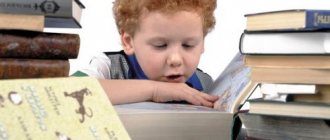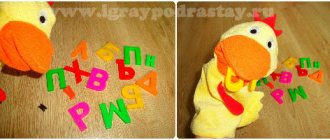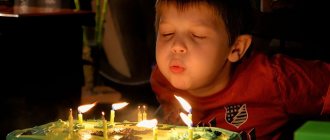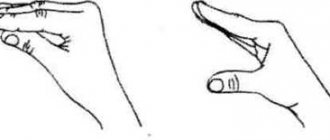Progress of the game:
Magpie - forty (the index finger of the right hand is performed
She cooked porridge, moving the palm of her left hand. Actions
She fed the children. accompanied by words, bend our fingers
Gave this one, (Little finger)
Gave this one, (Unnamed)
Gave this one, (Medium)
Gave this one, (Index)
I gave it to this one. (Big.)
“Like our cat”
Goal: Learn to perform game tasks, develop fine motor skills.
Exercises for fingers by Maria Montessori.
The games and exercises of Maria Montessori have now become very popular, although they are already more than a century old. Much attention in the Montessori system is paid to the motor development of children and specifically the development of fine motor skills. These exercises for fingers are actually the history of finger gymnastics - where it all began. Maria Montessori's system includes both exercises with special toys and objects, and everyday activities in everyday life - such as cleaning shoes, washing tables, watering flowers, cleaning metal objects (open a bottle of cleaning product, pour it into a cup, close the bottle, Clean the item with cotton wool and rub it until shiny with a polishing cloth).
Here I would like to talk about several exercises for the development of fine motor skills from Maria Montessori’s system.
1) Frames with fasteners. A wooden frame is made, which is covered with fabric from two halves. You need to match these halves and fasten the clasp. A part of the fastener is sewn to each half. Types of fasteners on frames:
a) large buttons, b) small buttons, c) buttons, d) bows, e) string that goes through holes, f) string that wraps around a hook, g) hooks and loops, h) strap fasteners, i) Velcro fasteners.
2) Board for feeling (texture: large - small).
Take a box with 10 boards measuring 10 by 9 cm, covered with rough sandpaper of different five types of texture from coarse-grained to fine-grained (five pairs of the same type of paper). The child's eyes are covered with a bandage. He is looking for pairs by touch. For the first games you need to take 2-3 pairs of boards, and then increase their number.
You can also lay out five planks in a row from the coarsest-grained surface to the finest-grained surface.
3) A box with pieces of fabric.
Material: The box contains pairs of pieces of fabric of different textures (silk, wool, cotton, artificial fiber; smooth and rough; hard and soft; thick and thin; durable, dense and loose. The task is to choose the same piece of fabric (find a pair).
How to perform the exercise: Method of action – palpation with the thumb and forefinger. The exercise is performed with eyes closed.
After completing the exercise: The baby explores the exercises and the fabrics around him - the textiles in the room, the fabrics of his clothes - what they are (smooth or rough, thick or thin).
4) Embroidery on cardboard . You will need pieces of thick cardboard on which the outlines of items to be embroidered are drawn. Use dots on the cardboard to mark the places where the needle should be pierced. You also need wool threads and a thick needle for carpet weaving.
First, an adult helps the baby make a knot, insert a thread into a needle, and make the first stitches. It is better to take the first steps hand in hand, then when the child gets comfortable, you can let go of his hand. The exercise is difficult for children, but very useful.
Never throw away such embroideries of children, appreciate them, find a use for them at home (use them as bookmarks, coasters, postcards), because they are not very easy for a child!
5) A box with seeds. The large compartment of the box contains seeds of various plants (pumpkin, sunflower, nasturtium, watermelon, melon and others). Pictures of these plants are attached to small compartments. The child sorts the seeds into the correct small compartments of the box. In this exercise, the baby not only practices sorting and develops fine motor skills, but also gets acquainted with plants - what they are called, how they differ from each other, what kind of seeds they have.
6) Exercises with water.
- Pouring from a teapot into a cup.
- Pouring water into a bottle with a narrow neck using a funnel.
- Watering flowers from a watering can
- Wiping the leaves of the flower with a sponge moistened with water (for example, ficus leaves).
- Cleaning the table with soap, a sponge and a brush (contaminated areas are wiped with a brush)
- Wringing out a sponge after washing a table or wiping plant leaves.
- Whipping the foam with a whisk (a little liquid soap is poured into the water using a pipette, and it is whipped into a fluffy foam).
- Washing doll linen and doll clothes, wringing them out and hanging them to dry on a line using clothespins.
These exercises require a clear sequence of actions and step-by-step instructions from an adult. They are not carried out in isolation, but are part of a holistic system of child development. Their basic principle is “help me do it myself.”
Progress of the game:
Children take turns stroking their fingers , first on one hand and then on the other hand.
Finger - boy , where have you been? (Stroke the thumb)
I washed my brothers on the river. (Wash hands)
I went to the forest with this brother, (Stroke the index finger)
I cooked cabbage soup with this brother, (Middle finger)
I ate porridge with this brother, (Ring finger)
I sang songs with this brother. (Little finger.)
October
"Where are the pens"
Goal: Activate finger .








